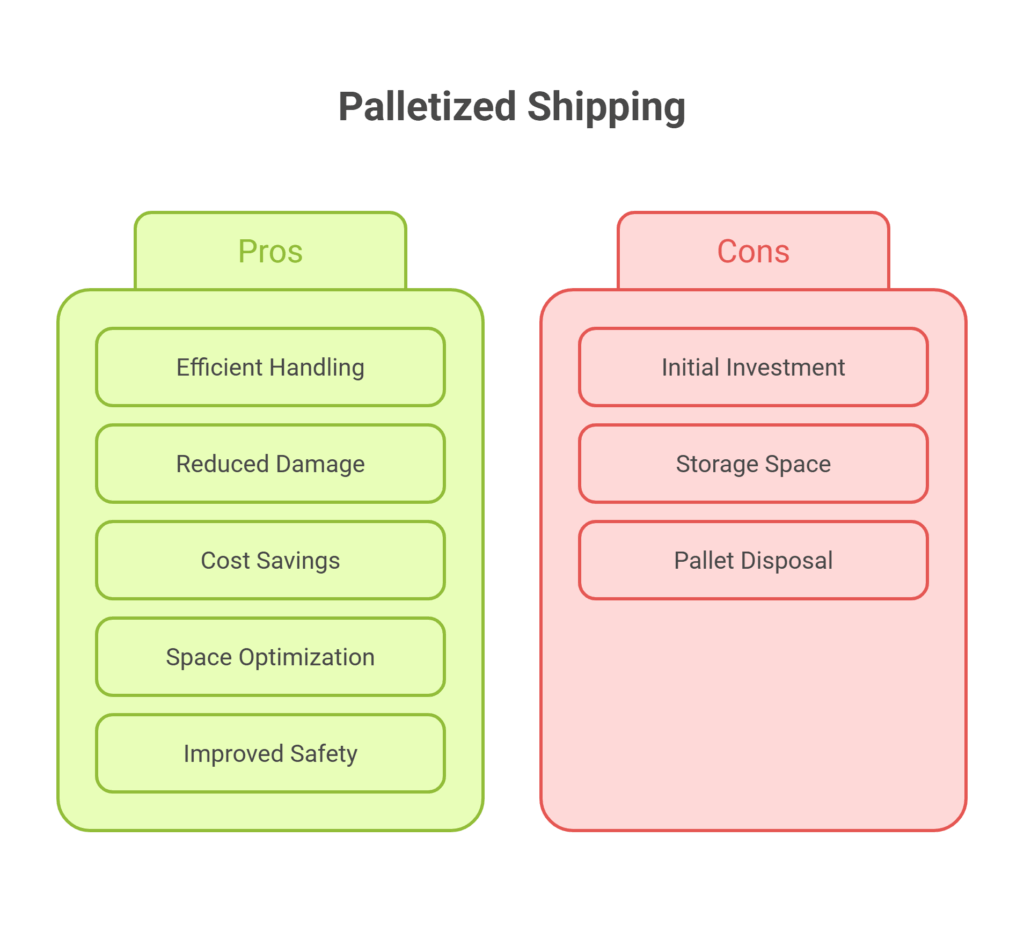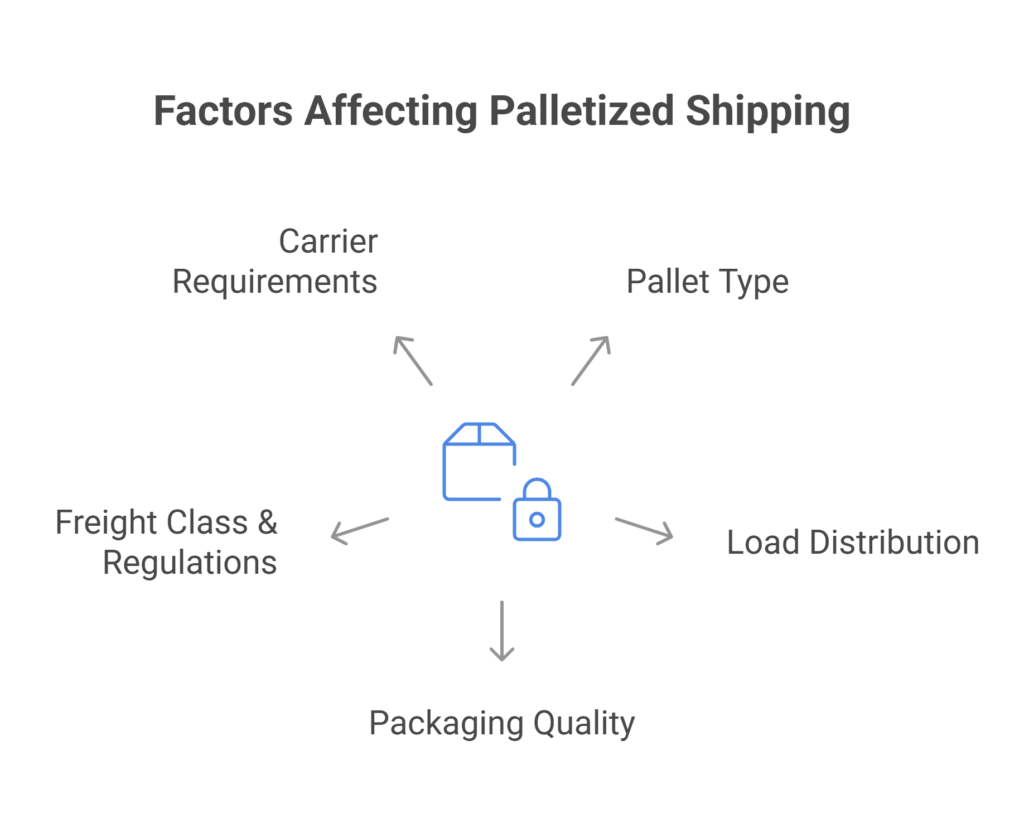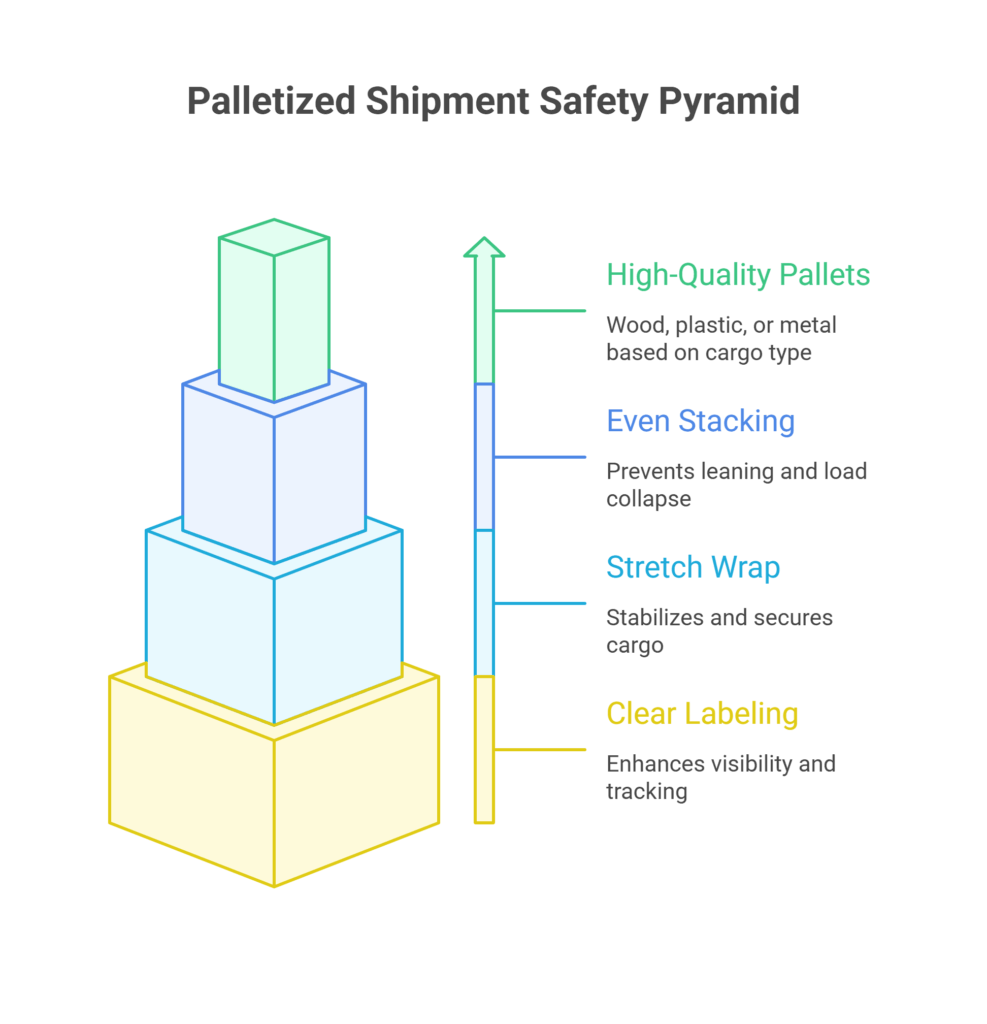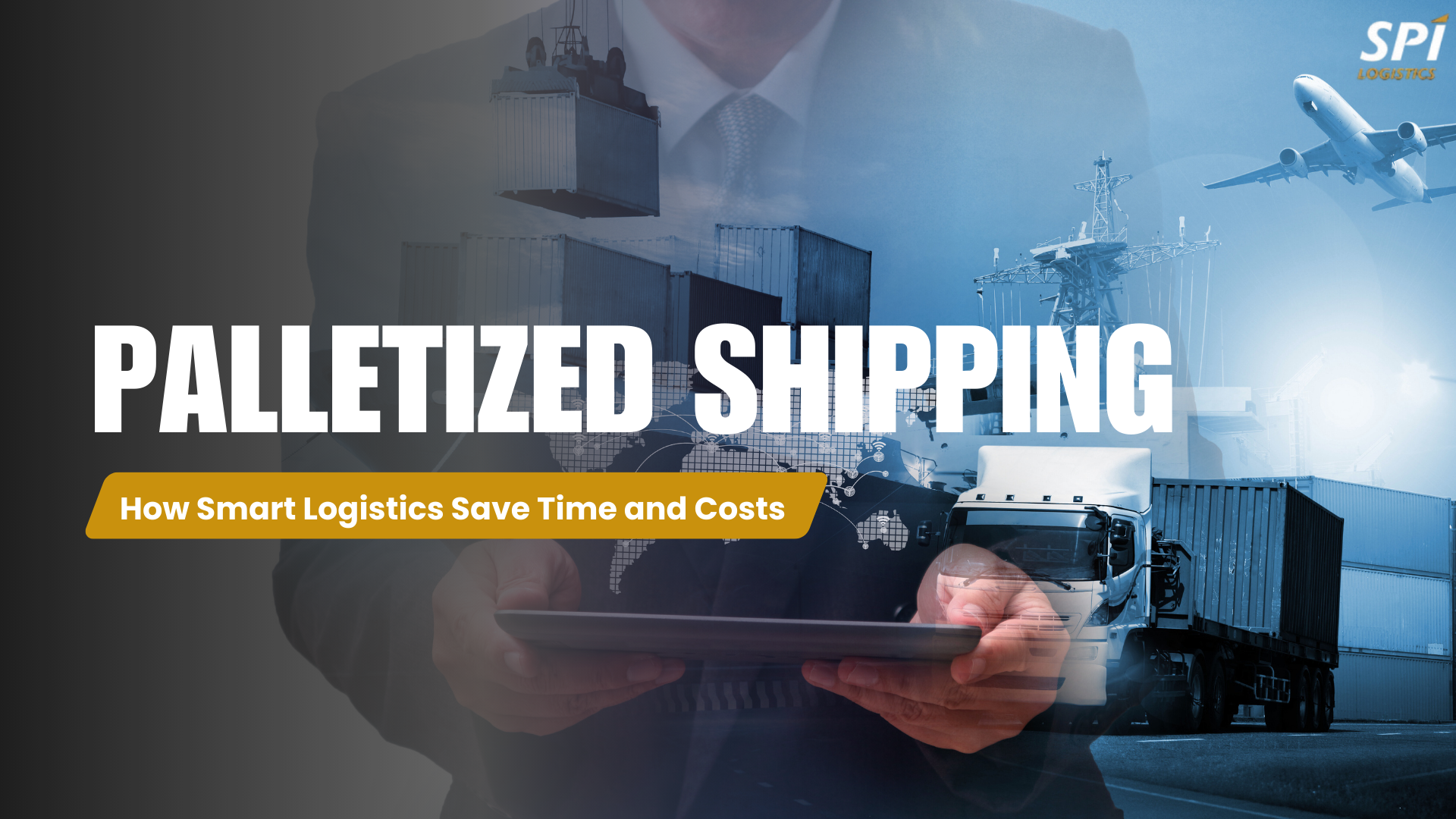When businesses look for ways to streamline their supply chain, palletized shipping often stands out as a powerful solution. By grouping products onto pallets, companies can minimize handling, reduce transit times, and cut costs. Whether you’re a small e-commerce store or a global distributor, understanding the advantages of pallet systems can transform your logistics strategy.
What is Palletized Shipping
Palletized shipping is the process of organizing goods on pallets before transportation. Products are stacked, wrapped, and secured onto wooden, plastic, or metal pallets, making them easier to move with forklifts or pallet jacks. This method enhances stability and protects cargo during transit.
For example: Imagine a warehouse shipping electronics. Instead of loading each box individually onto a truck (traditional shipping), they place multiple boxes of laptops on a single pallet, wrap it securely, and load it as one unit. This reduces handling time and minimizes product damage.
The Evolution of Palletized Freight
Logistics has come a long way from manual loading and unloading. Before pallets, goods were stacked loosely in trucks and ships, leading to slow handling, frequent damage, and higher costs. The rise of palletized freight transformed that model by allowing forklifts and cranes to move large volumes at once. Today, palletization is a global standard because it reduces labor, speeds up delivery, and simplifies warehouse operations.
Companies using palletized freight experience up to 60% faster loading times and 35% fewer damaged goods (Warehousing & Storage Association, n.d.).
“Adopting pallet systems has dramatically reduced our warehouse loading times and increased overall efficiency,”
How has your company’s approach to freight handling changed with the adoption of pallets?
Benefits of Palletized Shipping
Switching to palletized freight offers multiple advantages:
- Efficiency in Handling – Forklifts can move entire pallets at once, reducing loading and unloading times.
- Reduced Product Damage – Properly secured palletized shipments face less risk of crushing or mishandling.
- Cost Savings – Faster turnaround times mean lower labor costs.
- Space Optimization – Pallets allow for vertical stacking, maximizing warehouse and truck space.
- Improved Safety – Workers handle fewer loose boxes, lowering risks of workplace injuries.

“Palletization isn’t just about stacking boxes neatly; it’s about creating a safer and more efficient flow of goods from warehouse to customer.”
How could palletized freight improve efficiency in your own shipping process compared to handling individual items?
Factors Affecting Palletized Shipping
The success of palletised freight depends on several factors:
- Pallet Type – Wooden pallets are common, but plastic and metal pallets may be required for specific industries.
- Load Distribution – Evenly distributed weight prevents pallet breakage and maintains stability.
- Packaging Quality – Strong wrapping and strapping ensure the palletized shipment arrives intact.
- Freight Class & Regulations – Shippers must comply with size, height, and weight restrictions for palletized freight.
- Carrier Requirements – Different carriers may have rules on maximum pallet height and weight.

“Many shippers overlook pallet weight distribution, which is one of the leading causes of freight damage in transit.”
Which factor do you think has the biggest impact on the cost of palletized shipment, pallet size, weight, or packaging?
Palletized Shipping vs. Traditional Shipping
Traditional shipping refers to moving goods in loose boxes, crates, or containers without the use of pallets. Each item is loaded, unloaded, and handled separately. While this method can be useful for oddly shaped or oversized cargo, it often increases labor costs and risks of damage.
Comparing palletized shipping with traditional carton-by-carton loading reveals striking differences. With pallets, goods are consolidated and protected, while manual shipping involves higher labor costs and risks of product damage.
Key Advantages of Palletized Shipping
- Faster turnaround times at warehouses and ports.
- Safer handling and reduced injury risk for workers.
- Lower insurance premiums due to fewer claims.
Unlike traditional methods, palletized shipment allows for precise inventory control, especially when integrated with barcodes or RFID.
Over 75% of large-scale warehouses now use palletized shipping for at least 80% of their freight operations (Global Pallet Market Report, n.d.).
“The shift from traditional box handling to palletized shipping has transformed supply chains globally by reducing inefficiencies and workplace injuries.”
If you’ve used both methods, which do you find more cost-effective, palletization or traditional loading?
Mastering Palletized Shipment Safety
A palletized shipment is only as strong as its preparation. Poor stacking, weak pallets, or insufficient wrapping can lead to collapsed loads and damaged goods. To ensure safety and efficiency:
- Use high-quality pallets made from wood, plastic, or metal depending on cargo type (National Logistics Safety Board, n.d.).
- Stack evenly to avoid leaning loads.
- Apply stretch wrap to stabilize and secure the cargo.
- Label clearly for visibility and easy tracking. When shipments are palletized, goods are stacked evenly and secured with stretch wrap or straps. This dramatically reduces the chances of product shifting, crushing, or breaking during transport. Traditional shipping, by contrast, leaves individual items vulnerable.

Safety benefits:
- Stabilized loads
- Reduced worker injuries (less lifting of individual boxes)
- Fewer customer complaints about damaged goods
“Improper pallet preparation is the leading cause of cargo damage, so proper stacking and wrapping are non-negotiable.”
Want to ensure maximum safety for your shipments? Learn more about mastering freight compliance and risk management.
Palletized Freight in Global Trade
In global commerce, palletized freight is critical. Standardized pallet sizes ensure smooth transitions between ships, trucks, and warehouses, making international trade faster and safer. Palletization also plays a role in customs clearance, where organized loads are easier to inspect.
Trends in Global Palletization:
- Growth of reusable and eco-friendly pallets (International Trade Logistics Report, n.d.)..
- Increasing adoption of automation at ports.
- Convergence toward international size standards.
By adopting palletized freight, businesses gain smoother cross-border operations and stronger global supply chain resilience.
“We anticipate that the majority of international trade will rely on palletized cargo as automation and standardization increase.”
Do you think pallet standardization will eventually become mandatory worldwide?
Technology in Pallet Logistics
Modern logistics relies heavily on technology, and pallet systems are no exception. From RFID tracking to digital load optimization, technology ensures that palletized freight moves faster, safer, and with full visibility.
Key Technologies Enhancing Pallet Logistics
- RFID tags for real-time shipment monitoring (Logistics Tech Insights, n.d.)..
- Load sensors to prevent overstacking or tipping.
- Warehouse automation to speed up pallet movement (Logistics Tech Insights, n.d.)..
Integrating these tools with palletized shipping allows companies to make smarter decisions and reduce bottlenecks.
“Integrating tracking technology into our pallet systems has significantly decreased delays and improved inventory accuracy.”
Looking for ways technology can optimize your pallet operations? Explore advanced freight solutions
The Future of Palletized Shipping
Looking ahead, palletized shipping will continue to evolve with sustainability, automation, and innovation. Businesses are shifting toward eco-friendly pallets, robotic handling systems, and digital freight platforms. The move toward greener, smarter logistics will not only reduce costs but also meet growing environmental expectations.
In this future, palletized shipment will serve as the backbone of efficient supply chains, helping companies meet global demand while staying competitive.
A 2023 report from Green Logistics Research shows that companies using reusable pallets cut packaging waste by 20% and shipping costs by 15%.
“Smart pallets equipped with sensors will soon become the backbone of global supply chains, giving companies real-time visibility into their cargo.”
How do you see sustainability shaping the future of pallet logistics?
Frequently Asked Questions (FAQs)
1. Is palletized shipping always cheaper than traditional shipping?
Not always. While palletized freight often reduces labor and damage costs, shipping rates depend on weight, volume, and carrier pricing.
2. Can oversized cargo be palletized?
Not all cargo can be palletized. Oddly shaped or extremely large items may require traditional or customized shipping solutions.
3. What industries benefit most from palletized shipping?
Industries like retail, manufacturing, food, pharmaceuticals, and e-commerce gain the most due to high shipment volume and the need for protection against damage.
Master Palletized Shipping Strategies
Palletized shipping has become a cornerstone of modern logistics. By consolidating goods efficiently, ensuring safety, integrating technology, and embracing sustainability, businesses can achieve faster deliveries, lower costs, and higher customer satisfaction. As global trade expands, adopting palletized freight strategies is essential for companies looking to streamline operations and build resilient supply chains.
Ready to enhance your logistics and maximize efficiency? Contact us to implement expert palletized shipping solutions.
References
- International Trade Logistics Report. (n.d.). Global palletization trends. Retrieved from https://www.itlreport.com
- Warehousing & Storage Association. ( n.d.). Pallet efficiency statistics. Retrieved from https://www.wsa.org
- National Logistics Safety Board. (n.d.). Freight handling safety reports. Retrieved from https://www.nlsb.gov
- Logistics Tech Insights. (n.d.). Technology adoption in palletized logistics. Retrieved from https://www.logisticstechinsights.com
- Green Logistics Research. (2023, n.d.). Sustainability in pallet usage. Retrieved from https://www.greenlogisticsresearch.org
- Global Pallet Market Report.( n.d)., retrieved from https://www.globalpalletreport.com




